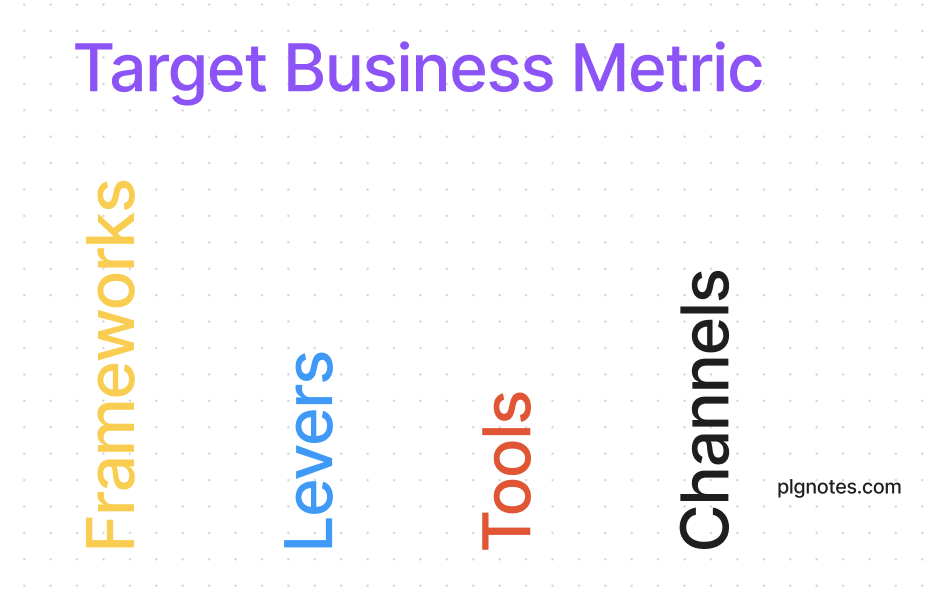Fundamental Approach to Product-led Growth Initiatives

I failed my job terribly during my early time as a PLG leader. Part of it was because I had no structured approach to driving growth initiatives. I treated my role as growth hacking versus finding a repeatable execution model. Anyway, those days are behind and I now have a model. The model certainly needs to evolve, mature, and stand through a longer time horizon but it’s a start. So, in this post, we will look at my fundamental approach to driving product-led growth initiatives.
Before we get into details, the model makes a core assumption - your product solves a real problem for your users and the user experience is good. It’s likely obvious but often understated. At the end of the day, PLG is a GTM motion that can only succeed if your users actually use your product. Anyway, moving on.
As a PLG function, you always start with a target business metric ( Note that this has to be a business metric and not a product metric). This is your starting point. You want to make a significant dent in this business metric in a relatively short period. You know your initiatives succeeded when the business metrics shows significant deviation from normal. At Sentry, our mission has been to get every developer to use Sentry. So, naturally, a target business metric during my initial days here was Monthly Active Users (MAUs). To create an impact around MAUs, we built a viral invitation loop in the product. As a result, we saw roughly 20% improvement in invitations and the impact has compounded over time.
Now that you have your target business metric, you want to analyze four core things:
1. Frameworks: This is where you structure your thinking on how to potentially impact the target business metric. Now. everyone should build frameworks that are relevant to their own industry/business. Here are a couple examples of frameworks I have used recently:
- Use Discover-Desire-Do to drive product/feature adoption goals. This is where you surface your new features in contextual places, create a desire for those features, and drive action on them. Read Grow New Product Adoption to dive deep into this framework.
- Use Three Folds Down to identify key elements impacting the target metric. This one is harder to define in words. So, let’s walk through an example. We talked about MAUs above and using invitations as a way to improve the metric. Following is a diagram on how I arrived at using invitations as a way to uplift monthly active users. Essentially, you keep looking a few folds down on what all things impact your target metric and eventually find an area that you can build strong hypothesis around.
2. Levers: Now, there are a ton of things you can do to impact change in your target business metric. However, not all things might be feasible within your resource (time, team size, skill set) constraints. So, we need to understand what levers can be pulled to drive potential impact. For e.g., product changes, GTM activities, price experiments, creating a sales funnel, etc. Product-led growth means different things to different companies. There are companies where the function is more marketing-focused and others where this is more product-focused. In an ideal world, you will be open to using any set of levers. The best case is when you can improve product experience, use GTM activities to surface the change and build a pipe behind the scenes to funnel high-value accounts to your enterprise team. With Invitations to improve MAUs, we improved product experience in a few ways:
- In-context invitations when assigning an issue
- Request-to-Join even when you don’t have an invitation
- Request-invite when your permission levels don’t allow sending invites
We, then, surfaced these capabilities through our monthly newsletter and wrote a blog on the topic. We even did a HackerNews post when the feature took off. All of this led to a compounding effect of inviting additional users and hence, higher monthly active users.
3. Tools: These days, nothing happens in the SaaS world without the right tools. You do need some core ones for your PLG efforts. These tools should allow you to track impact (Amplitude), run AB tests (PlanOut), and design new experiences (Figma). Check out details on the list of PLG tools here.
4. Channels: You want to understand various communication methods with your users. These typically include in-app, website, email, Slack/Discord, etc. Here’s a guide to PLG channels for user communication.